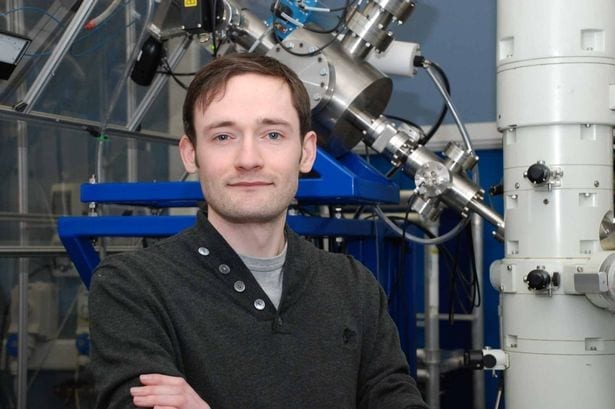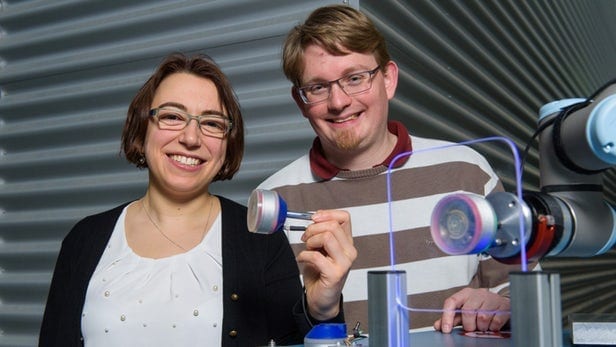
Scientists behind technologies at the tiniest scale may have new problems according to ‘surprising’ findings by Huddersfield University researchers
Nanotechnology – the manipulation of matter at a molecular or atomic scale – is used to make microchips denser and smaller.
The science, which modifies the very structure of what everything in the universe is composed of, is also used in cutting-edge radiotherapy and other medicine.
But the Emma (Electron Microscopy and Materials Analysis) research group, at Huddersfield University, has discovered the process used to transform nanoscale materials can cause much greater damage than was previously thought.
The team has an advanced facility named Miami (Microscope and Ion Accelerators for Materials Investigation), which is used to bombard materials with ion beams and examine the effects at the nanoscale.
During an experiment conducted by the team, including research fellow Dr Graeme Greaves, gold nanorods – a thousand times smaller than a human hair – were blasted with xenon atoms.
Gold nanowires were ideal materials for the experiment because they have a large surface area.
Dr Greaves said: “We were hoping to generate bubbles. We actually found that we were eroding the nanowires…
Dr Greaves added: “The research has considerable implications, particularly for medicine.
“More and more people are working on nanostructures for practical applications.
“Gold nanoparticles can be used for tumour detection, the optimisation of the bio-distribution of drugs to diseased organs and a radiotherapy dose enhancer.
“Components of computer chips are very small nowadays – in the order of 20 nanometres in size and getting smaller – and ion beams are used to change the properties of these materials.
“Our research shows you must be very wary of the amount of damage that may be done.”
The results were so dramatic the Huddersfield team sought a second opinion from Helsinki University, Finland.
The Latest on: Nanotechnology
[google_news title=”” keyword=”Nanotechnology” num_posts=”10″ blurb_length=”0″ show_thumb=”left”]
via Google News
The Latest on: Nanotechnology
- Scientists one step closer to breakthrough insulin pillon May 1, 2024 at 5:51 pm
An estimated 75 million people worldwide inject themselves with insulin roughly 6-7 times a day. Now, researchers are using nanotechnology to create a pill form of the medication, which includes a ...
- Unraveling the efficiency losses and improving methods in quantum dot-based infrared up-conversion photodetectorson May 1, 2024 at 1:33 pm
The researches on the visible-emitting CQDs and quantum dot-light emitting diodes (QLEDs) have been lasted for more than 20 years, and published hundreds of high-impact articles in well-known journals ...
- Researchers unlock potential of 2D magnetic devices for future computingon May 1, 2024 at 12:06 pm
Imagine a future where computers can learn and make decisions in ways that mimic human thinking, but at a speed and efficiency that are orders of magnitude greater than the current capability of ...
- Ancient farm practice could help sustain future humans on Marson May 1, 2024 at 11:00 am
“The best ‘Martian environment’ is actually simply a greenhouse with controlled conditions including temperature, humidity, and gasses,” Rebeca Gonçalves, a study co-author and astrobiologist at ...
- Activity in a room stirs up nanoparticles left over from consumer sprayson May 1, 2024 at 5:10 am
Common household products containing nanoparticles -- grains of engineered material so miniscule they are invisible to the eye -- could be contributing to a new form of indoor air pollution, according ...
- A step forward for self-health monitoring—wireless charging through a magnetic connectionon April 30, 2024 at 9:43 am
Zheng Yan and a team of researchers at the University of Missouri have made a significant breakthrough in their ongoing development of an on-skin wearable bioelectronic device. Yan's lab, which ...
- Scientists use nanotechnology to preserve Royal Navy's HMS Victory in Portsmouthon April 30, 2024 at 4:37 am
Vice Admiral Lord Nelson’s flagship vessel, HMS Victory, has fallen victim to fungus and the destructive deathwatch beetle. | ITV News Meridian ...
- NSF director Panchanathan, U.S. Sen. Young tout value of university-private sector partnerships to grow national, economic securityon April 29, 2024 at 9:52 am
“Purdue has a special connection with the National Science Foundation: from multiple Boilermakers leading the NSF in recent decades to a broad range of major NSF centers led by Purdue faculty,” said ...
- Quantum challenge to be solved one mile undergroundon April 29, 2024 at 8:32 am
Radiation from space is a challenge for quantum computers as their computation time becomes limited by cosmic rays. Researchers from Chalmers University of Technology, Sweden, and University of ...
- Nanotechnology in packaging: enhancing barrier properties and shelf lifeon April 29, 2024 at 4:29 am
Nanotechnology is revolutionising packaging materials, safeguarding products from spoilage and degradation while extending shelf life.
via Bing News










